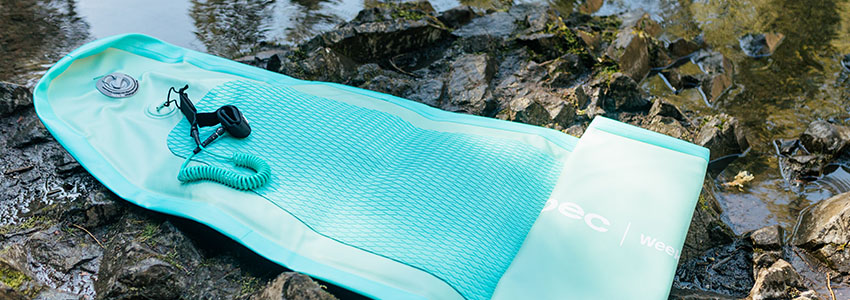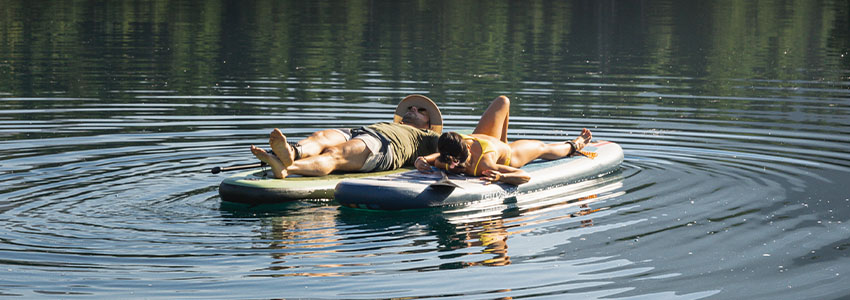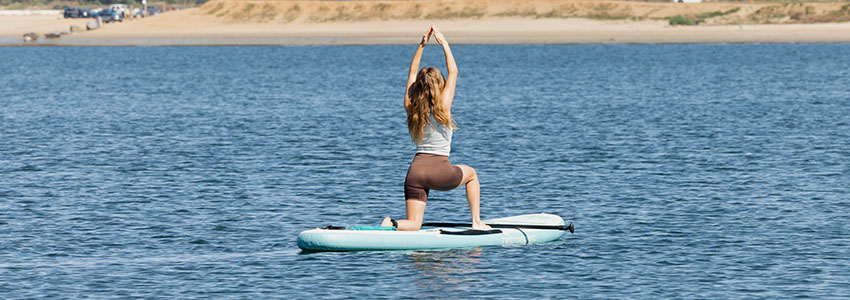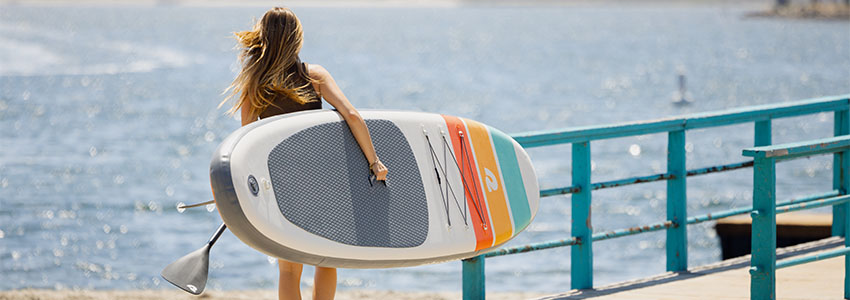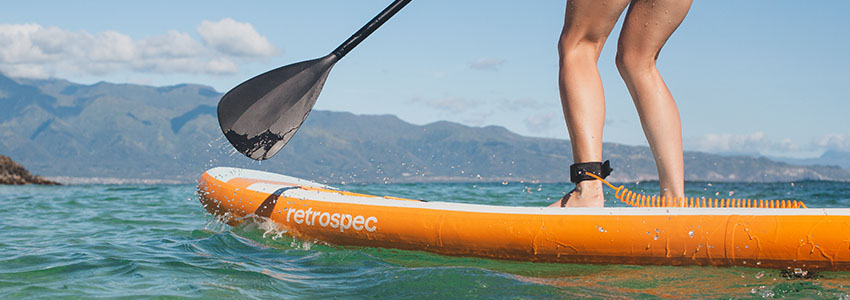Inflatable Paddle Boards vs. Solid: Why Inflatable Wins Every Time
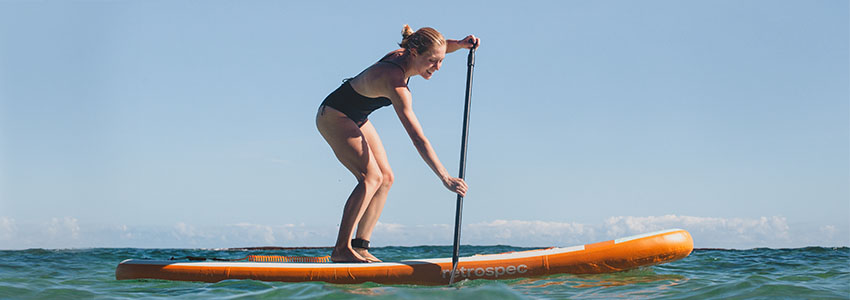
Paddle boarding has boomed in popularity in the last ten years. It’s a relaxing, fun way to explore the outdoors, and get in some great exercise as well. For water lovers, there’s no better way to spend a summer afternoon.
However, sometimes getting into paddle boarding can be expensive. Once you have your paddle board, you’re set, but the initial investment is high. How can you be sure you’re choosing a paddle board that’s right for you? Which should you buy, an inflatable paddle board, or a solid paddle board?
That’s where we come in. We’re experts in all things SUP (that’s stand-up paddle board for you newcomers). We put together this guide to help you find the perfect paddle board.
Inflatable Paddle Boards VS Solid Paddle Boards
What exactly is the difference between inflatable and solid paddle boards? Seems simple, right? One is hollow and inflates with a pump, the other is solid like a surfboard, but this is just the beginning of the distinctions.
Here at Retrospec, we’re firm believers in quality inflatables. They’re far more cost-effective, easier to pack and store, easier to learn on, more stable, and more durable.
Don’t just take our word for it, though. Let’s dive in and explore each of the ways that solid and inflatable paddle boards differ, so you can see for yourself.
Things to Consider
When you’re making a paddle purchase, there are a few considerations you should make. Once you’ve got a solid understanding of each of these, you’ll be ready to buy.
Portability/Storage
The first major consideration is storage. Paddle boards are huge, and this is a prohibitive factor for lots of people who may not have storage space. What if you don’t have a huge gear closet at home? What if your car doesn’t have a roof rack on top? What if you have to carry it to the lake?
The truth is, these are only issues for solid paddle boards. When deflated, inflatable paddleboards can easily fit anywhere— a coat closet, the trunk of your car, even on your back. With an inflated board, carrying is still easy as the inflatable SUP is super lightweight.
So even if you live in a small apartment, have a fuel-efficient sedan, and have to hike to your favorite lake, you’re covered. This is probably the most glaring difference between inflatable and solid SUPs, and it’s a clear win for inflatable.
Ease of Use
Which kind of paddle board is easier to learn on? Again, we’re going to give this one to inflatable stand up paddle boards. Inflatable SUPs are very stable and have a uniform thickness. This makes them easier to control and get onto.
Inflatable SUPs also have a higher weight capacity, allowing more people to use them however they like. Lastly, they have a softer surface. So if you do catch a rogue wave and take a tumble, you’re much less likely to get hurt.
Comparatively, solid and foam core SUPs take much more time to learn how to use. They’re thinner, harder to control, and have a hard surface. For beginners, inflatable SUPs are the obvious winner.
Versatility
It may not seem like it to a newcomer, but there are tons of ways to paddle board. Paddle boarding encompasses everything from SUP touring to fishing to yoga to surfing and more.
Solid paddle boards, while faster, are much less versatile than inflatable SUPs. Solid SUPs are more specialized for higher performance and high-speed activities like SUP racing and surfing.
But they’re not nearly as good for activities that require more stability or storage, like touring, yoga, and fishing. Furthermore, inflatable SUPs can do everything that solid SUPs can.
While solid SUPs may perform better in a few areas, they perform much worse in all the others. For this reason, inflatable paddle boards are much more versatile than solid paddle boards.
Durability
Durability is really a question of materials. Solid paddle boards are made of a combination of fiberglass and epoxy, like surfboards. More inexpensive models are made of foam.
Both of these are combinations you wouldn’t want to drop on the road or run into a rock. Particularly in the case of foam, solid paddle boards are not made to withstand impacts.
We’ve found that many people equate the budget-friendliness of inflatable SUPs with cheap construction, but that couldn’t be further than the truth.
Inflatable SUPs are sturdy by design. The consequences of getting a puncture while on the water would be nasty, so we over-engineer our SUPs to be bombproof.
As an example, at Retrospec, we make our inflatable SUPs out of rock-solid military grade PVC material with minimal seams and drop stitch technology. This creates an outer shell that will put up with way more abuse than any solid SUP on the market.
Lastly, solid epoxy boards are much harder to repair. Often, damage might not be repairable at all, but with an inflatable SUP, even if you do get a puncture, the board can be repaired by patching it right up.
Performance
Getting into the nitty gritty, which kind of SUP performs better? Like with most pieces of gear, it depends on what you’re using it for.
As we mentioned already, solid SUPs make huge sacrifices for better glide and speed, so if you’re a dedicated SUP surfer or racer, the drawbacks of a solid paddle board might be worth it.
However, that doesn’t mean inflatable SUPs can’t cruise. Streamlined inflatable designs (like the Weekender Tour are a close runner up for touring, racing, and surfing for their specialized nose and tails.
As for other kinds of SUP fun, inflatable paddle boards generally outperform solid SUPs. Inflatable SUPs are much more stable and can handle everything from chop to flat water, making them much better for yoga, fishing, and general recreational use.
In short, solid SUPs make huge sacrifices for slightly better glide. This makes them perform better when SUP surfing and racing. However, in all other categories (SUP yoga, fishing, touring, and general use), inflatable paddle boards win.
Accessories
Having accessories for your paddle board might not be the first thing on your mind when shopping, but they can make a huge difference for a lot of different activities.
For example, if you’re into SUP surfing, you’re going to want to have a leash. If you like touring, a bungee cable and features for easily carrying your SUP are invaluable. For SUP fishing, mounting points for rod holders can be really helpful.
So which kind of paddle board is easier to accessorize? In this way, they’re pretty even. Both kinds of paddle boards can come with storage options like bungee cords and straps. Both can have mounting points. Both can have places to attach a leash.
Inflatable paddle boards might get a slight plus in this category for how packable they are — you won’t need extra storage space or roof racks to transport them. Retrospec paddle boards come with a carrying case, which is ideal for packing your SUP in and out.
Cost
For some people, cost is the only object. Some people see the quality of a paddle board boiled down to a single number. Other people just want to find something inexpensive to start with, but experienced paddle boarders know it’s a lot more complicated than that.
In short, inflatable SUPs cost about a third as much as solid paddle boards. You can expect to pay anywhere from $300-$500 for an inflatable paddle board, depending on the specifications. Larger paddle boards with more features and accessories are more expensive.
Solid paddle boards typically range from $800-$1,200. Many people assume that the high cost of solid SUPs means they’re superior to inflatable paddle boards, but the truth is that inflatable SUPs are just much less expensive to produce.
Usually, when buying outdoor gear, going with the less expensive option means making some kind of sacrifice, but with paddle boards, you can have the best of both worlds!
Inflatable SUPs are high-quality, durable, versatile, stable, easy to use, and perform well all-around. And they cost a fraction of what you would pay for a solid paddle board!
In A Nutshell
Now that we’ve done a deep dive on the pros and cons between inflatable and solid paddle boards, let’s sum everything up.
Inflatable paddle boards are:
Much less expensive
Very easy to store, transport, and carry
Far more durable
Very versatile
Stable under more weight
Easy to learn how to use
High-performance tools for lots of different activities
On the other hand, solid paddle boards:
Cost two to three times more
Have a bulky construction that’s hard to store, transport, and carry
Are made of less durable, harder to repair materials
Are specialized for speed, but don’t perform as well at low speeds
Have lower weight ratings
Are much harder to mount, balance on, and learn to control
Perform very well in just a few areas, but perform much worse in every other area
By now, we hope we’ve made our case. Inflatable paddle boards are the clear winner for their smart design and cost effectiveness. Whether you’re a beginner or an expert, you’ll find something to love in an inflatable paddle board.



